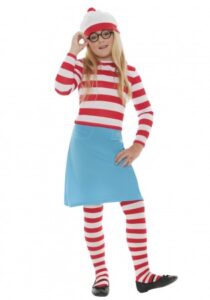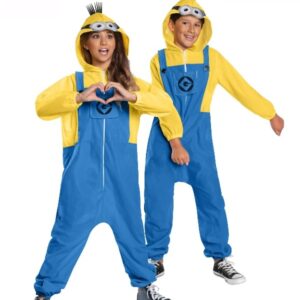When it comes to dressing up, few characters capture the imagination quite like Wally from the beloved “Where’s Wally?” series. Known for his distinctive red-and-white striped shirt, bobble hat, and glasses, Wally has become a popular choice for costume parties, Halloween, and themed events. However, when selecting a Where’s Wally costume, you may notice some differences between adult and children’s versions. Let’s delve into these distinctions and understand what sets them apart.
Size and Fit
The most obvious difference between Where’s Wally costumes for adults and kids is the size. Adult costumes are designed to fit a range of adult body sizes, with varying lengths and widths to accommodate different heights and builds. Children’s costumes, on the other hand, are scaled down to fit younger wearers. They often come in a broader range of sizes to match the rapid growth rates of kids, from toddlers to pre-teens.
Material and Comfort
Manufacturers also consider the material and comfort level differently for adults and kids. Children’s costumes are usually made from softer, more durable materials that can withstand rough play and are easy to clean. They might also feature fewer small parts and accessories to reduce choking hazards. Adult costumes, while also focusing on comfort, might incorporate materials that offer a more authentic look or detailed accessories, potentially at the cost of a bit more maintenance.

Design Details
When it comes to the design specifics, adult Where’s Wally costumes might include more intricate details to closely mimic Wally’s appearance in the books. This can include more precise patterns on the shirt, a more structured hat, or even higher quality glasses. Kids’ costumes, while still recognisable, might simplify some of these details to ensure the costume is safe and comfortable to wear. For example, the glasses included with children’s costumes are often made of soft, flexible plastic without lenses.
Accessories
Accessories play a significant role in differentiating adult and children’s costumes. Adults’ costumes might come with a range of accessories, such as a walking stick, a satchel, or even a magnifying glass, to complete the look. Children’s costumes, focusing on safety and ease of use, might limit accessories or opt for safer, child-friendly versions. For instance, a child’s satchel might be made of lightweight material with Velcro closures instead of buckles.
Safety and Practicality
Safety is a paramount concern for children’s costumes. Features that might pose a risk, such as long cords, tight necklines, or small, detachable pieces, are usually modified or omitted in kids’ versions. Additionally, children’s costumes often include practical elements like Velcro fastenings for easy dressing and undressing, wider neck openings, and sometimes even visibility features like reflective strips for trick-or-treating after dark.
Adult costumes, while still adhering to safety standards, assume a level of responsibility and care from the wearer. This allows for a bit more flexibility in design and accessory choices, making adult costumes potentially more complex or true to the character’s look in the illustrations.
Purpose and Usage
Lastly, the intended purpose and usage can influence the design of Where’s Wally costumes. Adult costumes are often designed with social events, parties, and detailed cosplay in mind, where achieving a close match to Wally’s iconic look is desirable. Kids’ costumes, however, are designed with play, comfort, and versatility in mind, allowing children to enjoy wearing their costume in various settings, from parties to playdates, without constraints.
To sum up, while both adult and children’s Where’s Wally costume captures the spirit and fun of the character, differences in size, material, design details, accessories, safety, and intended use are carefully considered by manufacturers. It doesn’t matter if you’re an adult looking to impress at a costume party or a child eager to embark on your own adventures, there’s a Where’s Wally costume out there designed with your needs in mind.




